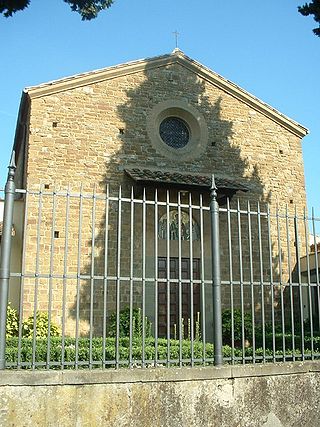
San Leonardo in Arcetri is a Romanesque-style, Roman Catholic church located on Via di San Leonardo #25, a few hundred meters southeast of the Porta San Giorgio of Florence, Italy.

The Church of the Gesù is the mother church of the Society of Jesus (Jesuits), a Catholic religious order. Officially named Chiesa del Santissimo Nome di Gesù, its façade is "the first truly baroque façade", introducing the baroque style into architecture. The church served as a model for innumerable Jesuit churches all over the world, especially in Central Europe and in Portuguese colonies. Its paintings in the nave, crossing, and side chapels became models for art in Jesuit churches throughout Italy and Europe, as well as those of other orders. The Church of the Gesù is located at the Piazza del Gesù in Rome, and is one of the great 17th century preaching churches built by Counter-Reformation orders like the Jesuits in the Centro Storico.

Sant'Andrea della Valle is a titular church and minor basilica in the rione of Sant'Eustachio of the city of Rome, Italy. The basilica is the seat of the general curia of the Theatines and is located on the Piazza Vidoni, at the intersection of Corso Vittorio Emanuele and Corso Rinascimento. It is one of the great 17th century preaching churches built by Counter-Reformation orders in the Centro Storico.

The Basilica of San Frediano is a Romanesque church in Lucca, Italy, situated on the Piazza San Frediano.

Montevarchi is a town and comune in the province of Arezzo, Tuscany, Italy.

Sant'Anna dei Lombardi,, and also known as Santa Maria di Monte Oliveto, is an ancient church and convent located in piazza Monteoliveto in central Naples, Italy. Across Monteoliveto street from the Fountain in the square is the Renaissance palace of Orsini di Gravina.

Matteo Rosselli was an Italian painter of the late Florentine Counter-Mannerism and early Baroque. He is best known however for his highly populated grand-manner historical paintings.

The Basilica della Santissima Annunziata del Vastato is the Catholic cathedral of Genoa, northern Italy; its decoration employed the major baroque studios and artists in Genoa in the 17th century.

The Basilica of Saint Nicholas of Tolentino is a Roman Catholic church and minor basilica that is part of the Augustinian monastery in the hill-town of Tolentino, province of Macerata, Marche, central Italy. The church is a former cathedral of the Roman Catholic Diocese of Tolentino, suppressed in 1586.

San Gaetano, also known as Santi Michele e Gaetano, is a Baroque church in Florence, Italy, located on the Piazza Antinori, entrusted to the Institute of Christ the King Sovereign Priest.

The Basilica dell'Osservanza is a church on the outskirts of Siena, region of Tuscany, Italy.

Santa Maria del Sasso, also known as the Sanctuary of Santa Maria del Sasso is a Renaissance church near Bibbiena in Tuscany, Italy.

Antonio Brilla was a prolific Italian sculptor and ceramic artist mainly active in Liguria. He travelled in 1838 to Florence to study masterworks, where he met Giovanni Duprè and Lorenzo Bartolini. He returned to Savona to establish a studio. Two of Antonio's sons also were artists.

The church of San Barnaba is a small Renaissance-style church in the center of Florence, at the corner of Via Panicale and Via Guelfa.

Andrea di Niccolò, also Andrea di Niccolò di Giacomo, (1440–1514) was an Italian painter of the Sienese School.

Santa Maria in Provenzano, or the Insigne Collegiata di Santa Maria in Provenzano, is a late-Renaissance-Baroque style, Roman Catholic, collegiate church in Piazza Provenzano Salvani, in the Terza Camollia, just southwest of the basilica of San Francesco, in the city of Siena, region of Tuscany, Italy. This Marian shrine was built around a 14th-century terracotta icon of the Madonna, which was credited with miracles. The Palio of Siena takes place on the day of veneration of this Marian devotion.
The Collegiata Santo Stefano is a late-Baroque style, Roman Catholic church in Monte San Giusto, Province of Macerata, region of the Marche, Italy.

Santissima Trinità is a Renaissance-style, Roman Catholic church in via Elisa in central Lucca, region of Tuscany, Italy.
The Collegiate Church of Santa Maria Assunta is a Gothic church located in Sermoneta, southern Lazio, Italy. The church is often referred to as a cathedral ("cattedrale") but has never been the seat of a bishop. It is dedicated to the Assumption of the Virgin Mary.

San Leone, once called the oratory or church of Santo Spirito, is a small Baroque-style Roman Catholic church located adjacent to the Vivarelli Colonna in Pistoia, region of Tuscany, Italy. In 2017, restoration of the Baroque era frescoes in the apse and ceilings were completed.




















